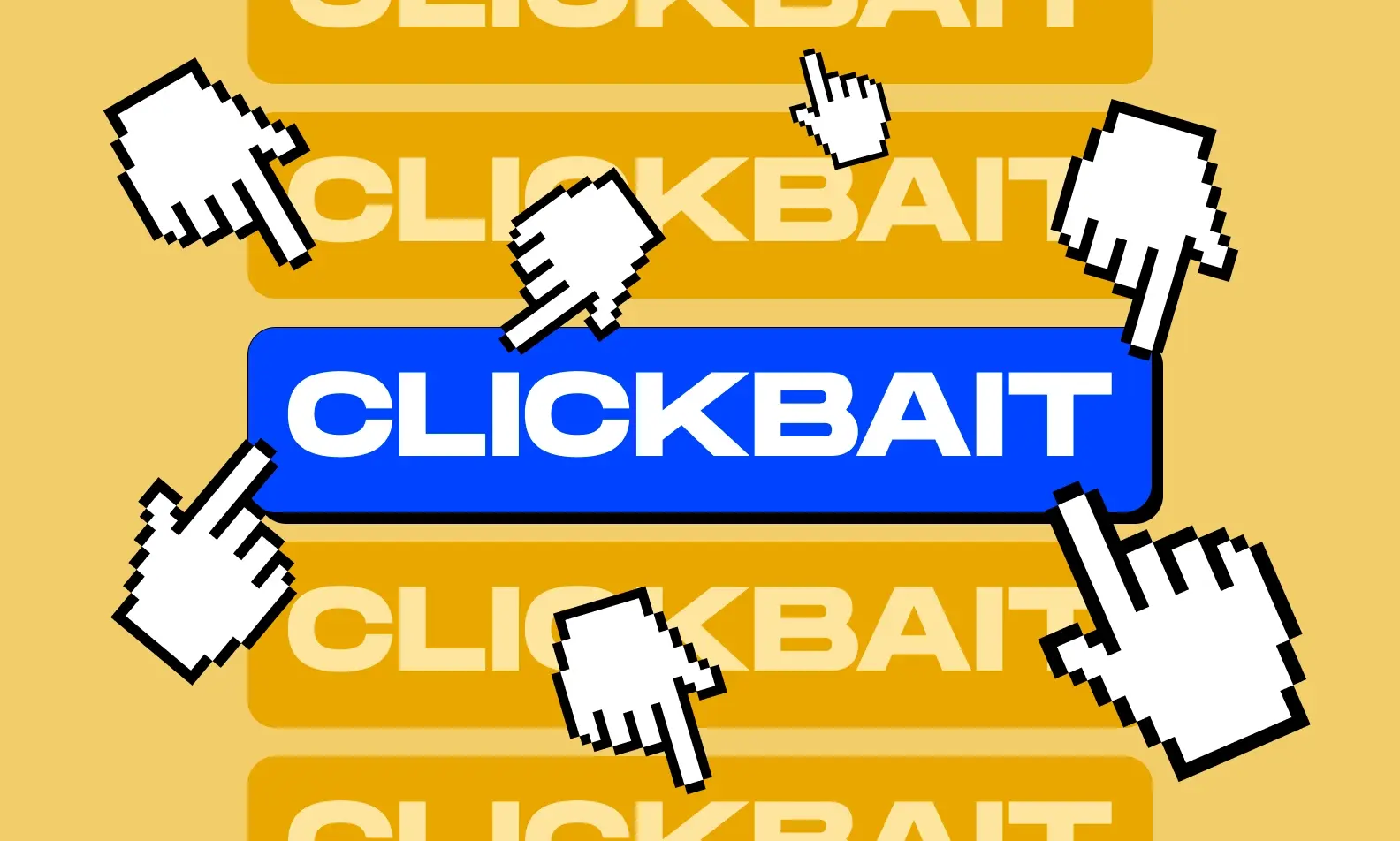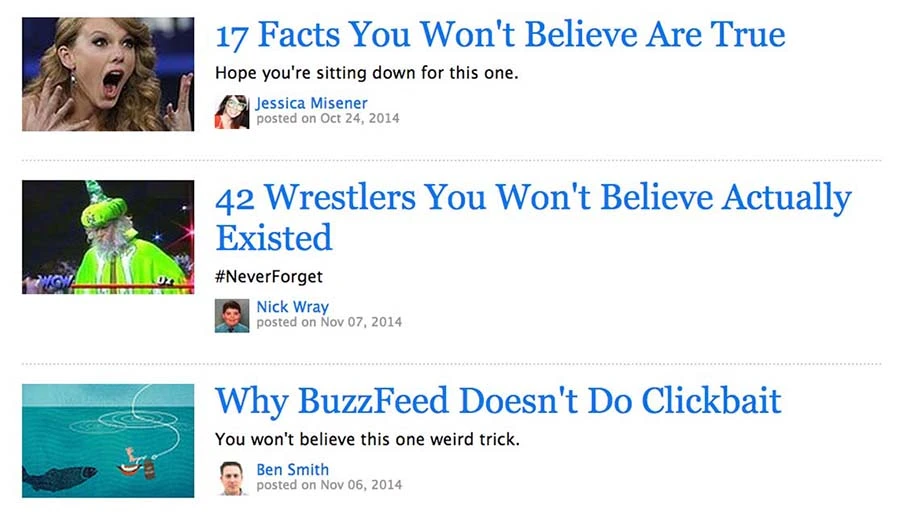9 Ways to Ethically Use Clickbait in Your Content Strategy

In this digital age of misinformation, clickbait has become both a buzzword and a contentious tactic used to grab audiences’ attention. You see it everywhere in headlines, thumbnails, and content teasers across the internet. Its prevalence raises questions about its true nature and effectiveness within our digital ecosystem.
Understanding its allure, impact, and the ethical considerations surrounding it is vital in deciphering its role in online content creation. In this article, we’ll examine the use of clickbait within digital media and reveal how you can ethically incorporate this tool into your content creations.
What Is Clickbait?
Clickbait serves as a marketing and engagement strategy employing sensationalist, misleading, and deceptive content in its headlines, thumbnails, or teasers to allure clicks and boost page views. Its primary goal is to captivate users by offering intriguing or shocking information, with the ultimate aim of directing traffic to a specific website or platform. Frequently encountered on platforms such as YouTube through enticing thumbnails and titles or as advertisements on news articles like Upworthy or Buzzfeed. Unfortunately, clickbait content tends to fall short of the excitement, accuracy, or value promised, leaving users disappointed with the content they actually encounter.
Although commonly associated with online media, the roots of clickbait can be traced back to the 19th century, when newspapers vied for circulation through attention-grabbing headlines. Fast forward to the 21st century, and the tradition has evolved into catchy blog titles, further fueled by the rise of SEO and the desire of brands to increase website traffic. Nowadays, clickbait tactics are common across diverse digital content types, from listicles on marketing tools to sensational claims about monthly search visitors, perpetuating the practice of intentionally over-promising or misrepresenting content to induce clicks.
Types and Examples of Clickbait
Clickbait's effectiveness lies in its ability to trigger emotional responses like curiosity, shock, or excitement. It taps into users' psychology, leveraging their desire for instant gratification or the need to satisfy curiosity. These elements often prompt increased engagement and clicks. Below are three great examples of how clickbait is used to grab viewers' attention.
1. Exaggerated Headlines:
These are headlines that go beyond factual information, often making promises or exaggerating details in a way that exceeds what the content actually delivers. For instance, some headlines might say, "Unbelievable Secrets Revealed! or “You Won't Believe What Happens Next!" By heightening expectations, these headlines persuade users to click on an article that looks sensationalized but ultimately turns out to be misleading.

2. Misleading Images:
Clickbait also involves the use of misleading or unrelated images to capture attention. By presenting images that may not directly correspond to the content, creators aim to intrigue users and prompt them to click, exploiting the visual appeal to generate curiosity and drive engagement. An example could be a before and after image of a celebrity with the caption stating “20 Actors Then and Now” or “You Won’t Believe What Happened to These Actors.” These images can be deceiving as the later image is typically photoshopped or not the person at all.

3. Showy Thumbnails:
Utilizing eye-catching thumbnails that may not accurately represent the content is another common clickbait tactic. These thumbnails, designed to grab attention and spark curiosity, sometimes mislead viewers about the actual substance of the content, encouraging clicks based on visual allure rather than content accuracy. For instance, a YouTube thumbnail displaying a shocked face with the caption "Epic Surprise!" may mislead users into expecting a more dramatic revelation than the content delivers.

Pros & Cons of Clickbait
While effective in certain aspects, clickbait also brings challenges and drawbacks that influence how audiences perceive content. Understanding these nuances is essential for content creators navigating the digital landscape. Here are some of the pros and cons of using clickbait in your content:
Pros of Clickbait
- Increased Clicks: Clickbait has the potential to substantially increase click-through rates and elevate the visibility of content, driving traffic and expanding the audience reach.
- Enhanced Engagement: The attention-grabbing nature of clickbait frequently leads to increased interactions, boosting engagement in viewership and encouraging audiences to delve further into the content.
Cons of Clickbait
- Credibility Loss: Employing misleading tactics in clickbait can have damaging consequences, causing harm to the credibility of a brand or creator and potentially losing the audience’s trust.
- Audience Distrust: The excessive use of clickbait may contribute to audience skepticism and distrust. As viewers become wary of the brand or creator’s misleading content, the overall perception of their authenticity becomes impacted.
- High Bounce Rates: Clickbait that fails to deliver on its promises can lead to high bounce rates, with users swiftly leaving a site after realizing the content does not align with their expectations. This can negatively affect engagement metrics, preventing the potential for continued audience interaction.
7 Clickbait Strategies to Avoid
Content creators must be vigilant and avoid specific clickbait strategies that can negatively impact audience trust and credibility. Here are ethical guidelines to follow:
- False Promises: Avoid making promises in titles or thumbnails that the content fails to deliver. Misleading viewers with false or exaggerated information can significantly damage credibility and lead to audience disappointment.
- Exaggerated Claims: Refrain from overstating or exaggerating content details to the point of misinformation. Excessive exaggeration can result in audiences feeling misled or dissatisfied.
- Ambiguous Titles: Steer clear of intentionally vague or ambiguous titles that provide little information about the actual content. Ambiguity can confuse audiences, causing them to lose genuine interest and trust in the creator.
- Sensationalism Without Substance: Avoid using sensationalist tactics solely to grab attention without substance in the content. While attention-grabbing headlines or thumbnails are acceptable, they must accurately represent the content's essence.
- Clickbaiting Serious or Sensitive Topics: Be cautious when using clickbait strategies for serious or sensitive topics. Sensationalizing such content can lead to audience backlash and damage the creator's reputation.
- Manipulative Emotional Triggers: Avoid manipulating emotions like fear or outrage solely for clicks. Ethical content creation should prioritize authenticity and respect for the audience's emotions and sensibilities.
- Misleading Thumbnails or Previews: Do not use thumbnails or preview clips that misrepresent the content. Such tactics can lead to audience frustration and distrust.
9 Ways to Use Clickbait in Your Content Strategy
Content creators can ethically engage audiences without misleading tactics by leveraging curiosity and value in their content. Here are nine effective strategies:
1. Curiosity-Driven Titles:
Generate captivating titles that spark curiosity and faithfully reflect the content within. Intrigue your audience by teasing fascinating aspects or posing questions that encourage exploration while maintaining transparency to ensure viewers are not misled about the content. Craft titles that serve as an enticing gateway to the valuable and intriguing information that awaits your audience.
2. Value-Oriented Thumbnails:
Design visually striking thumbnails that authentically capture the essence of your content while emphasizing its inherent value. Use images or visuals that genuinely pique interest and avoid the use of misleading representations to maintain transparency with your audience. Ensure your thumbnails provide an accurate preview, enticing viewers with a clear depiction of the value they can expect from your content.
3. Authentic Teasers:
Provide authentic sneak peeks or teasers within your titles or thumbnails, offering a truthful glimpse into the core of your content. By providing genuine previews, you encourage viewers to explore further, generating engagement while upholding authenticity in your messaging. Craft teasers that authentically reflect the substance of your content, creating a transparent and compelling invitation for your audience to delve deeper.
4. Highlighting Benefits:
Showcase the benefits, insights, or unique offerings viewers can gain by engaging with your content. Accentuate the content's value without resorting to sensationalism or exaggeration, ensuring a genuine representation of the advantages awaiting your audience. Design your messaging to transparently showcase the real and meaningful benefits, fostering a connection with viewers based on your content's authentic value.
5. Tease Compelling Content Aspects:
Tease specific aspects or segments of the content that are particularly engaging or intriguing. By strategically highlighting compelling content aspects, you create curiosity that encourages viewers to delve deeper and explore the full extent of your content. Create teasers that entice your audience with the promise of captivating elements, motivating them to embark on a journey of discovery within your content.
6. Factual and Informative Descriptions:
Compose factual and informative descriptions or captions that precisely convey the focus of your content, offering valuable insights without succumbing to hype or false claims. Ensure your descriptions provide an accurate representation of the content. This will establish trust with your audience by delivering transparent and reliable information.
7. Use of Intriguing Keywords:
Integrate relevant and intriguing keywords that precisely describe your content, sparking curiosity among potential viewers. By strategically incorporating keywords that align with your content's essence, you can pique your audience's interest while maintaining accuracy and transparency. Provide your content with keywords that optimize discoverability and entice viewers with a clear representation of what awaits them.
8. Preview or Intro Snippets:
Offer brief and genuine snippets or introductions that provide a tantalizing glimpse into the nature of your content without divulging too many details. By crafting introductory snippets, you create intrigue and anticipation, compelling viewers to explore further and discover the full extent of your content. Ensure these previews strike a balance, offering enough insight to capture interest while leaving room for exploration.
9. Interactive Elements:
Enhance viewer engagement by incorporating interactive elements such as polls, questions, or teasers within your content, creating a dynamic and collaborative experience. By seamlessly integrating these interactive features, you not only capture audience attention but also maintain transparency about the nature of the content.
Explore Fourthwall's Creator Platform
Explore Fourthwall's Creator Platform, offering content creators a suite of tools to establish authentic branding and create audience trust. With customizable homepages reflecting unique styles, personalized shops for relevant merchandise sales, and exclusive membership options, creators can nurture loyalty by creating a reliable brand that their followers trust. Join Fourthwall to build meaningful relationships with your audience today!
















